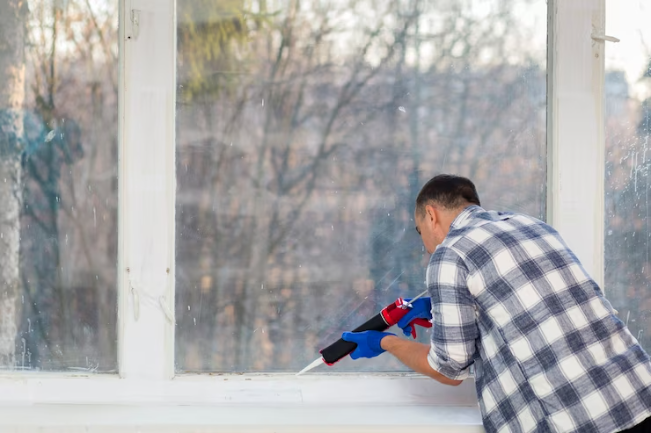If you’re experiencing drafts and leaks in your home, it’s likely that your windows are about to repair. This can not only be uncomfortable, but it can also lead to higher energy bills as your AC or heater tries to compensate for the loss of air.
But before you rush out to replace your windows, there are some relatively simple steps you can take to address the issue and potentially save yourself some money.
In this article, we’ll be going over some basic window repair techniques to help you deal with drafts and leaks. We’ll cover identifying the source of the problem, sealing and caulking your windows, installing weatherstripping, upgrading your windows, and maintaining them for long-term results.
By the end of this guide, you’ll have a good understanding of how to tackle window repair on your own, and how to keep your home comfortable and energy-efficient.

Identifying the Source of Drafts and Leaks
You might not realize it, but your home could be letting in unwanted cold air and moisture, causing discomfort and potentially damaging your property. Let’s find out where these sneaky intruders are coming from.
Common causes of drafts and leaks include gaps around windows, damaged weather stripping, and worn-out caulking. These issues can be fixed with DIY solutions such as applying weather stripping or caulk to seal gaps.
However, if the drafts or leaks are severe, it may be necessary to seek professional repair options. A professional can assess the damage and determine if window replacement is necessary. In some cases, the issue may not even be the window itself but instead the framing or insulation.
In these situations, a professional can identify and address the underlying issue to ensure the problem is fully resolved.
Sealing and Caulking Your Windows
Congratulations! You’ve just discovered a new and exciting hobby: creating indoor wind tunnels with your windows. But if you’d rather not feel like you’re living in a tornado, it might be time to seal and caulk those pesky gaps.
Sealing your windows is one of the most important steps you can take to reduce drafts and keep your home comfortable. Start by cleaning the window frames and glass thoroughly with a mild detergent and warm water. Be sure to remove any old caulk or peeling paint to ensure a smooth and even surface.
Once your windows are clean, it’s time to apply the caulk. There are a range of options available, including silicone, acrylic, and latex-based products. If you’re looking for eco-friendly options, look for products that are water-based or made from natural materials.
Apply the caulk in a continuous and even bead along the gap, using a caulk gun or your fingers to smooth it out. Don’t forget to seal around the edges of the window frame and any other areas where air might be escaping.
With a little bit of effort, you’ll soon be enjoying a draft-free home that’s both comfortable and energy-efficient.
Installing Weatherstripping
To further improve the energy efficiency of your home, consider installing weatherstripping to prevent any unwanted air infiltration. Weatherstripping is a material used to seal gaps around doors and windows, preventing drafts and energy loss.
There are many types of weatherstripping available, including adhesive-backed foam tape, V-strip, and door sweeps. When installing weatherstripping, it’s important to follow proper installation techniques to ensure that it’s effective.
Start by cleaning the surface where the weatherstripping will be applied, ensuring it’s dry and free from dust and debris. Measure the gap around the door or window and choose a weatherstripping material that’s the appropriate size. Apply the weatherstripping carefully, making sure it’s evenly spaced and free from wrinkles or gaps.
Finally, test the seal by closing the door or window and checking for any gaps or drafts. With proper installation, weatherstripping can greatly improve the energy efficiency of your home and save you money on your energy bills.
Upgrading Your Windows
If you want to make your home more energy efficient, upgrading your windows is a great option. Old windows can be a major source of drafts and leaks, which can lead to higher energy bills and a less comfortable living space.
Fortunately, there are cost-effective options for upgrading your windows that can provide significant energy savings. One option is to install double-pane windows, which have two layers of glass with a layer of insulating gas in between. This design helps to reduce heat transfer through the window, which can lead to lower energy bills and a more comfortable home.
Another option is to install low-emissivity (low-e) windows, which have a special coating that reflects heat back into your home during the winter and reflects it away during the summer. This can help to keep your home at a more consistent temperature throughout the year, which can lead to significant energy savings.
Maintaining Your Windows for Long-Term Results
Maintaining your windows is essential for achieving long-term energy efficiency and a comfortable living space. Preventive measures can go a long way in avoiding costly repairs or replacement down the road.
Regularly inspecting your windows for any signs of damage, such as cracks or gaps, can help you catch any drafts or leaks early on. Additionally, keeping your windows clean and well-maintained can help extend their lifespan and improve their overall performance.
DIY solutions can also be a cost-effective way to maintain your windows. For example, if you notice a draft coming from the bottom of your window, you can easily apply weather stripping to seal the gap. If you have older windows, you may want to consider adding storm windows or using window film to improve insulation.
By taking these simple steps, you can keep your windows in top condition and enjoy a more comfortable and energy-efficient home for years to come.
In this article, we’ll explore the various factors to consider when deciding whether it’s time to call a professional for your home repairs.
Frequently Asked Questions
Can I repair a broken window myself, or do I need to hire a professional?
If you’re considering repairing a broken window yourself, there are a few things to keep in mind. DIY repairs can be a cost-effective solution, but it’s important to have the right tools and skills to ensure the job is done correctly.
If you’re not comfortable with working on windows or don’t have experience with home repairs, it might be best to hire a professional. A skilled professional can assess the damage, recommend the best course of action, and ensure the repair is done safely and effectively.
Ultimately, the decision to DIY or hire a professional will depend on your comfort level and the severity of the damage.
How can I tell if my windows need to be replaced instead of repaired?
Are you wondering if it’s time to replace your windows instead of repairing them? There are a few indicators to look out for.
If your windows are more than 20 years old, it may be time to consider replacement. Additionally, if you notice significant damage such as rotting frames or broken glass, replacement is likely necessary.
However, if the issues are minor such as drafts or leaks, DIY repairs may be possible. It’s important to weigh the cost of repairs versus replacement and consider hiring a professional for more complex repairs or replacements.
Ultimately, the decision to replace or repair your windows depends on the extent of the damage and your budget.
Are there any eco-friendly options for weatherstripping and sealing windows?
When it comes to weatherstripping and sealing your windows, there are several eco-friendly options available.
One option is to use silicone or rubber weatherstripping, which can be easily installed using adhesive tape or screws.
Another option is to use draft stoppers, which can be made from eco-friendly materials such as wool or recycled cotton.
In addition, you can use caulking or sealant to fill gaps or cracks around your window frames.
To ensure proper installation techniques, it’s important to clean and dry the area before applying any weatherstripping or sealant.
By using eco-friendly options and proper installation techniques, you can reduce drafts and leaks in your home while also being environmentally conscious.
Will upgrading my windows increase the value of my home?
Upgrading your windows can be like giving your home a facelift, making it look fresh and new. It’s not just about improving the appearance of your property. It can also increase its value by adding curb appeal and making it more energy-efficient. By upgrading to high-quality windows, you can reduce your energy bills and enjoy greater comfort. Thanks to better insulation and improved temperature control, energy-efficient windows can save you up to 25% on your energy costs. So, if you’re looking to boost your home’s value and save money in the long run, upgrading your windows is a smart investment.
How often should I have my windows professionally inspected and maintained?
To keep your windows functioning properly and preserving their lifespan, it’s important to have them professionally inspected and maintained regularly. The frequency of window maintenance depends on various factors such as the age of the windows, the climate in your area, and whether or not you’ve experienced any issues with drafts or leaks.
Typically, it’s recommended to have your windows inspected and maintained every 2-3 years. However, if you notice any signs of damage or wear and tear, it’s important to take action immediately to prevent further damage.
Additionally, there are some DIY window repair tasks that you can perform on your own, such as cleaning and lubricating the tracks and adjusting the hardware, which can help extend the lifespan of your windows.
Conclusion
Congratulations! You’re now an expert in window repair!
You’ve learned how to identify the source of drafts and leaks, seal and caulk your windows, install weatherstripping, and even upgrade your windows. You’ve done it all.
But here’s the ironic truth: the best way to deal with drafts and leaks is to prevent them from happening in the first place. That’s right.
The key to long-term window maintenance is simple: regular cleaning and inspections.
By keeping your windows clean and checking for any signs of wear and tear, you can catch and fix problems before they turn into major issues.
So, while you now have all the skills and knowledge necessary to handle any window repair job, the real secret to success is prevention.
Keep your windows in top shape, and you won’t have to deal with drafts and leaks ever again. Happy repairing!

